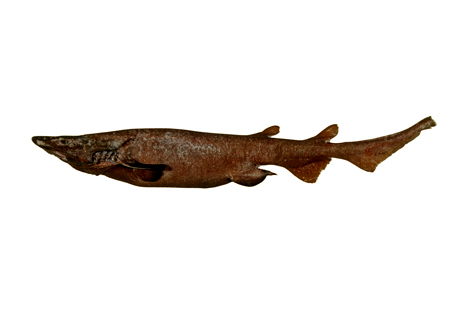Bulldog Catshark, Apristurus pinguis Deng, Xiong & Zhan 1983
Other Names: Fat Catshark

Bulldog Catshark, Apristurus pinguis. Source: Australian National Fish Collection, CSIRO. License: CC by Attribution-NonCommercial-ShareAlike
Summary:
A medium brown catshark with paler, barely visible flecks, a darker brown underside, irregular pale blotches on the head, and white teeth.
Cite this page as:
Bray, D.J. 2023, Apristurus pinguis in Fishes of Australia, accessed 25 Apr 2024, https://fishesofaustralia.net.au/home/species/2618
Bulldog Catshark, Apristurus pinguis Deng, Xiong & Zhan 1983
More Info
|
Distribution |
Off Broken Bay, New South Wales, around southern Australia including Tasmania, to off Beachport, South Australia. Elsewhere the species occurs in the north-west Pacific, eastern Indian Ocean and New Zealand. |
|
Features |
Vertebrae 102–107 (34–35 monospondylous) Snout relatively short, broad, wider than long, length less than 4 times eye diameter, slightly flattened and bell-shaped anterior to nostrils; teeth widely spaced, mostly with 3 cusps in males, and 5–7 cusps in females, central cusps long, needle-like, and much longer than adjacent cusps; denticles tricuspidate, closely spaced; anal-fin triangular, deep and short, its height about equal to its base length; pectoral fin relatively broad, shorter than width of head near mouth. |
|
Etymology |
Thespecific name is from the Latin pinguis (= fat) in reference to the “stout” body of this species. |
|
Species Citation |
Apristurus pinguis Deng, Xiong & Zhan 1983, Oceanologia et Limnologia Sinica 14(1): 64, fig. 1. Type locality: East China Sea, 26°-31°N, 125°-128°E, depth 200-1000 m. [in Chinese, English summary] |
|
Author |
Bray, D.J. 2023 |
|
Resources |
Bulldog Catshark, Apristurus pinguis Deng, Xiong & Zhan 1983
References
Compagno, L.J.V., Dando, M. & Fowler, S. 2005. A Field Guide to the Sharks of the World. London : Collins 368 pp.
Deng, S.-M., Xiong,G.-Q. & Zhan, H.-X. 1983. Description of three new species of elasmobranchiate fishes from deep waters of the east China Sea. Oceanologia et Limnologia Sinica 14(1): 64-70 [in Chinese, English summary]
Huveneers, C. & Duffy, C.A.J. 2015. Apristurus pinguis. The IUCN Red List of Threatened Species 2015: e.T44222A70708974. https://dx.doi.org/10.2305/IUCN.UK.2015-4.RLTS.T44222A70708974.en. Accessed on 21 August 2023.
Kawauchi, J., Sasahara, R., Sato, K. & Nakaya, K . 2008. Occurrence of the deep-water catsharks Apristurus platyrhynchus and Apristurus pinguis in the Indian and Western South Pacific Oceans (Carcharhiniformes: Scyliorhinidae). pp. 75-92 in Last, P.R., White, W.T. & Pogonoski, J.J. (eds). Descriptions of new Australian chondrichthyans. CSIRO Marine and Atmospheric Research Paper No. 022: 1-358. http://hdl.handle.net/102.100.100/118353?index=1
Last, P.R. & Stevens, J.D. 1994. Sharks and Rays of Australia. Canberra : CSIRO Australia 513 pp. 84 pls. (as Apristurus sp. E)
Last, P.R. & Stevens, J.D. 2009. Sharks and Rays of Australia. Collingwood : CSIRO Publishing Australia 2, 550 pp.
Nakaya, K., Sato, K., Kawauchi, J. & Stewart, A.L.2015. 14 Family Scyliorhinidae. pp. 75-89 in Roberts, C.D., Stewart, A.L. & Struthers, C.D. The Fishes of New Zealand. Wellington : Te Papa Press Vol. 2 pp. 1-576.
White, W. 2008. Shark Families Heterodontidae to Pristiophoridae. pp. 32-100 in Gomon, M.F., Bray, D.J. & Kuiter, R.H. (eds). Fishes of Australia's Southern Coast. Sydney : Reed New Holland 928 pp. (as Apristurus sp. 4)
White, W.T., Last, P.R. & Pogonoski, J.J. 2008. Apristurus bucephalus sp. nov., a new deepwater catshark (Carcharhiniformes: Scyliorhinidae) from southwestern Australia. pp. 105-112 in Last, P.R., White, W.T. & Pogonoski, J.J. (eds). Descriptions of new Australian chondrichthyans. CSIRO Marine and Atmospheric Research Paper No. 022: 1-358. http://hdl.handle.net/102.100.100/118353?index=1




